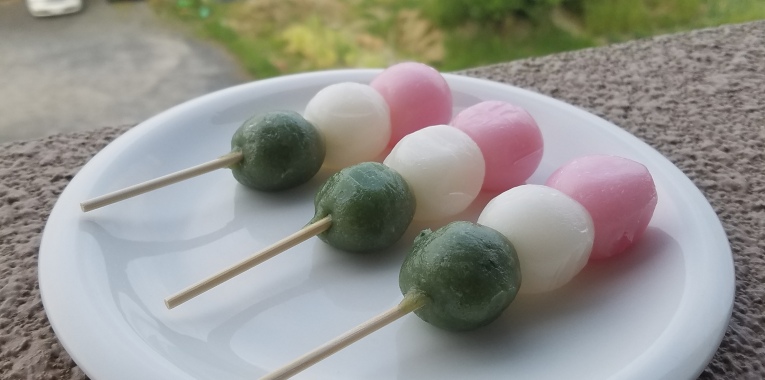Sun and I go way back. Ever since I saw my first sunrise over 22 years ago, we have been close friends; we’re almost always together! But some days, I just need my space. Today was one of those (admittedly many) days. No, it’s not really his fault, but sometimes he is just so energetic and bright that I have to bask in the shade indoors while he shines on.

I guess he is just getting in the summer mood, but late May is, at least for me, still too early for me to get hyped about that just yet. To honor spring’s final moments, I enjoyed some Sanshoku Dango on my balcony in the cool evening.

Sanshoku Dango (literally translates to Three-Color Dumplings) is a cute, sweet Japanese confectionery that most people think of when they hear the word dango. In case you’ve never heard of it, let this emoji spare me a thousand words of explanation 🍡.

As you can see, sanshoku dango consists of three multicolored balls of mochi poised on a skewer for easy eating. Pink. White. Green. Always in that order. I thought each ball would have a different flavor, but my research (both first-hand and online) suggests that this hypothesis is false.
Only the green ball has a unique yomogi (mugwort) flavor, but it is very subtle. From all my experiences eating and making mugwort sweets in the past, I expected a taste bolder and earthier than the leafy wisps I barely noticed. After two slightly-sweet mochi balls in a row, I expected a bigger climax, but oh well.

The texture of the three mochi balls are what really sell this treat though. Unlike normal mochi, dango mochi is significantly more gummy, bouncy, and chewy. It felt like I was chewing on bubblegum, but it was not as rubbery. I took my time enjoying each mochi ball before moving onto the next, and since I had a total of nine mochi balls (dango is often served in sets of three), my cool evening felt particularly long and relaxing.

But even though the taste is only decent and the texture is the only thing I’ve complimented, I want to give more credit to the Sanshoku Dango’s visuals. The colorful pink, white, and green of the dango certainly catches one’s attention among other single-colored mochi desserts, but its connection with the spring runs deeper than that. You see, this particular type of dango is most commonly eaten around the time of Girl’s Day in Japan (March 3rd), when spring is starting to spring forth. As such, one theory claims that the pink represents cherry blossoms, the white represents leftover snow, and the green represents newborn sprouts. Another theory suggests that the three colors wholly represent cherry blossom pink buds, white flowers, and green leaves.
Whatever the truth may be, all I know for sure is that my Sanshoku Dango was a pleasant treat for reminiscing on the spring. I think I’ll be ready for the summer sooner than later, but for now I’m content.
